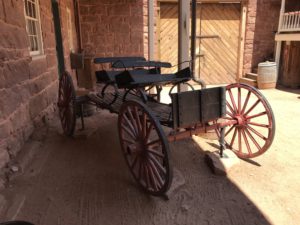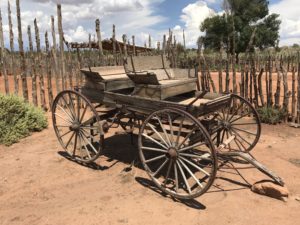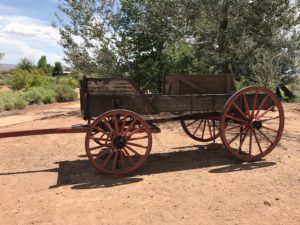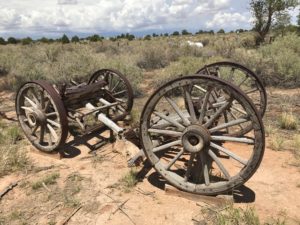
Wagons were an important form of transportation for pioneers heading west and for everyday transportation. Here at Pipe Spring we have six wagons scattered around the monument. Each wagon is a little different. Today I give you an opportunity to see and learn about the Pipe Spring wagons.
The first wagon you encounter at Pipe Spring is a broken freight wagon just outside the Visitors Center. It’s as if the wagon broke in just that location and never moved again. Freight wagons were built to carry heavy loads over rough roads for long distances. The front wheels are smaller than the back wheels to allow for easy maneuvering. the axles are large and able to hold heavy loads. A stabilizing beam connects the front and back wheels. The stabilizing beam on this wagon had a knot in the wood which caused the wagon to break.
The second wagon is the working freight wagon. These wagons could haul 1,000 pounds of supplies. Mules or oxen usually pulled these wagons. A hand brake is position at the front right wheel. There are no springs under the wagon.
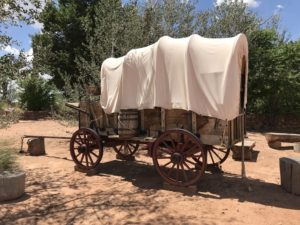
The third wagon is a chuck wagon. Chuck wagons were designed in 1866 as mobile kitchens on cattle drives. It also served as a cowboy’s blacksmith shop, infirmary, and social hot spot. The chuck wagon carried all the equipment needed for the comfort and safety of the cowboys.
Wagon #4 is a buckboard wagon. Used for work and play, the buckboard was light and fast. One or two horses bulled the buckboard. The name comes from a board put up in front of the driver’s seat to protect their legs in case the horse decided to buck.
The fifth wagon is a platform spring wagon, the multipurpose wagon of its day. These wagons were used to transport people or belongings. There are springs on the undercarriage making it durable and comfortable. The seats are adjustable, providing more leg room. The back seat could be removed for extra storage.
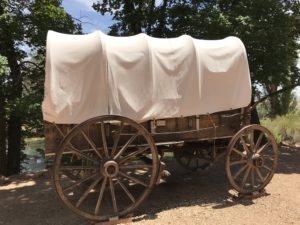 The final wagon is the iconic covered wagon. Most pioneers took a farm wagon and fit five to six wooden bows over the box as supports for a canvas cover. A family could store their belongings comfortably for the long trip across the plains. These wagons carried about 2,000 pounds of belongings and people. The wagons jolted those who rode in them, so only the sick, elderly, very young, and the driver would ride. Everyone else preferred the relative comfort of walking.
The final wagon is the iconic covered wagon. Most pioneers took a farm wagon and fit five to six wooden bows over the box as supports for a canvas cover. A family could store their belongings comfortably for the long trip across the plains. These wagons carried about 2,000 pounds of belongings and people. The wagons jolted those who rode in them, so only the sick, elderly, very young, and the driver would ride. Everyone else preferred the relative comfort of walking.
Just like modern cars and trucks, wagons came in many shapes and sizes with specialized uses. These vehicles were adapted to the needs of the owners. All of the wagons here at Pipe Spring were used here during the late 1800’s. Some of them have been restored by our creative and caring maintenance staff. They are currently working on a buggy that may find its place as wagon #7 on the grounds.
Our visitors love to see the wagons decorating the grounds. When I am doing my living history spinning demonstration, I sit beside the covered wagon. It helps me get in the historic mood and makes a wonderful backdrop for pictures.

